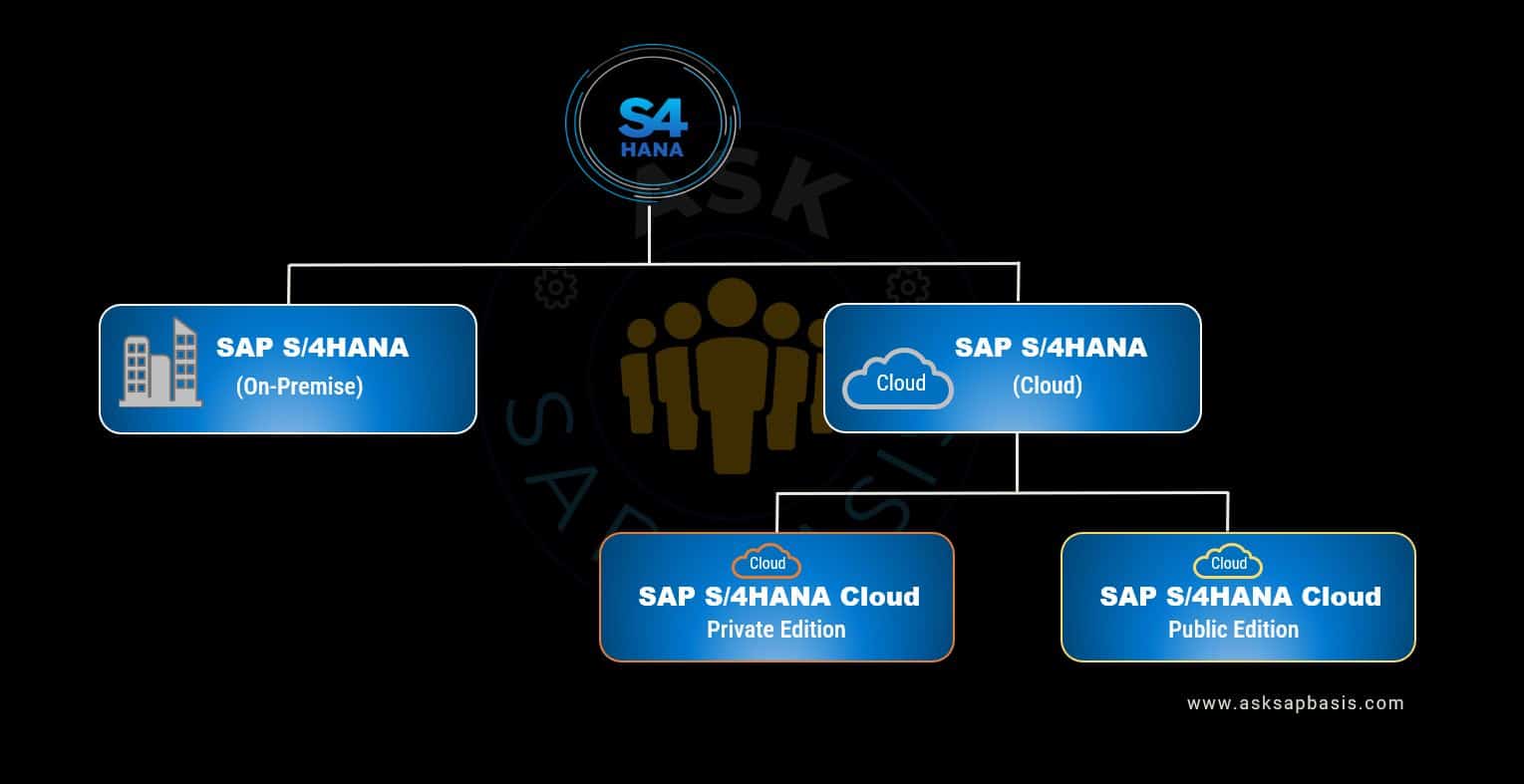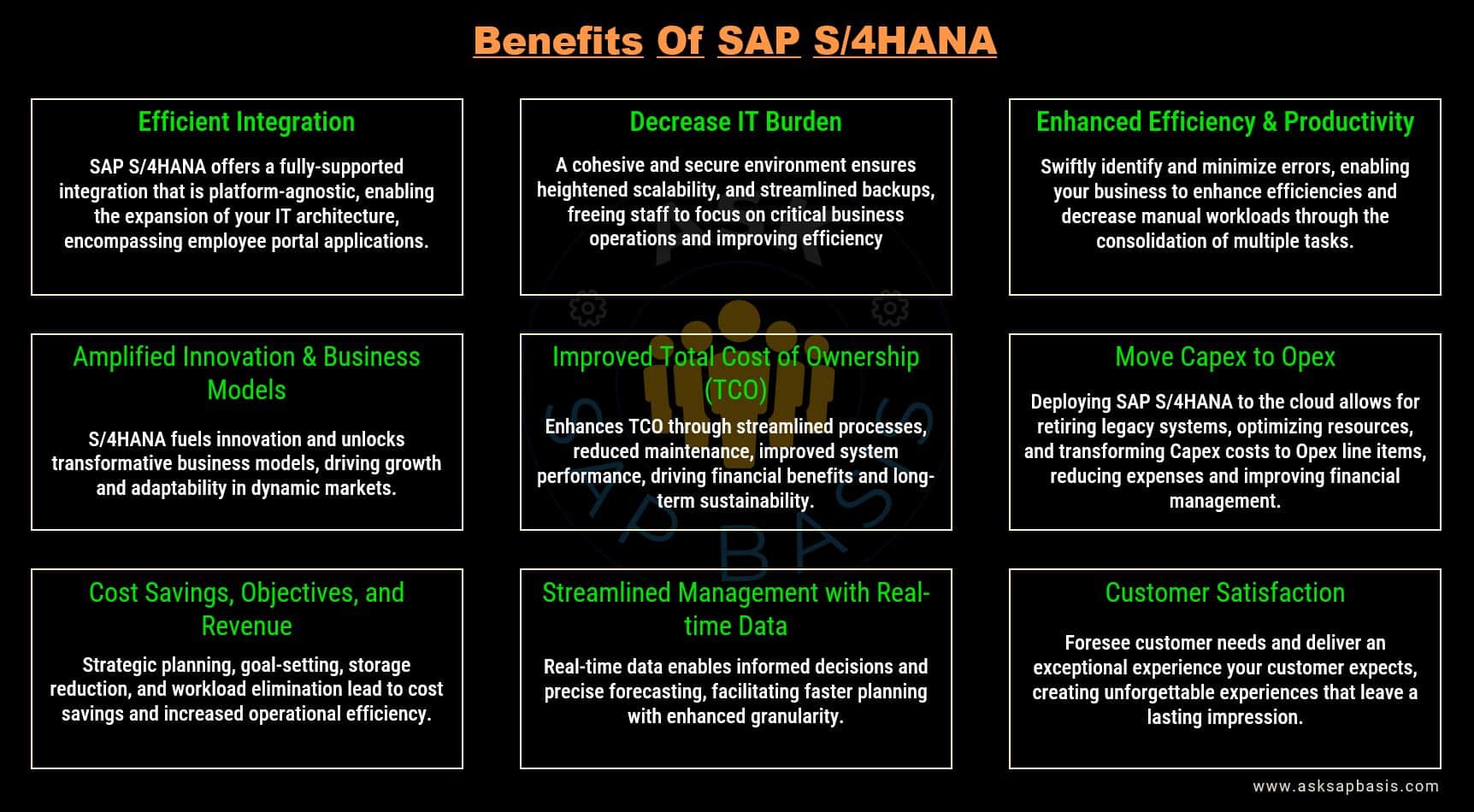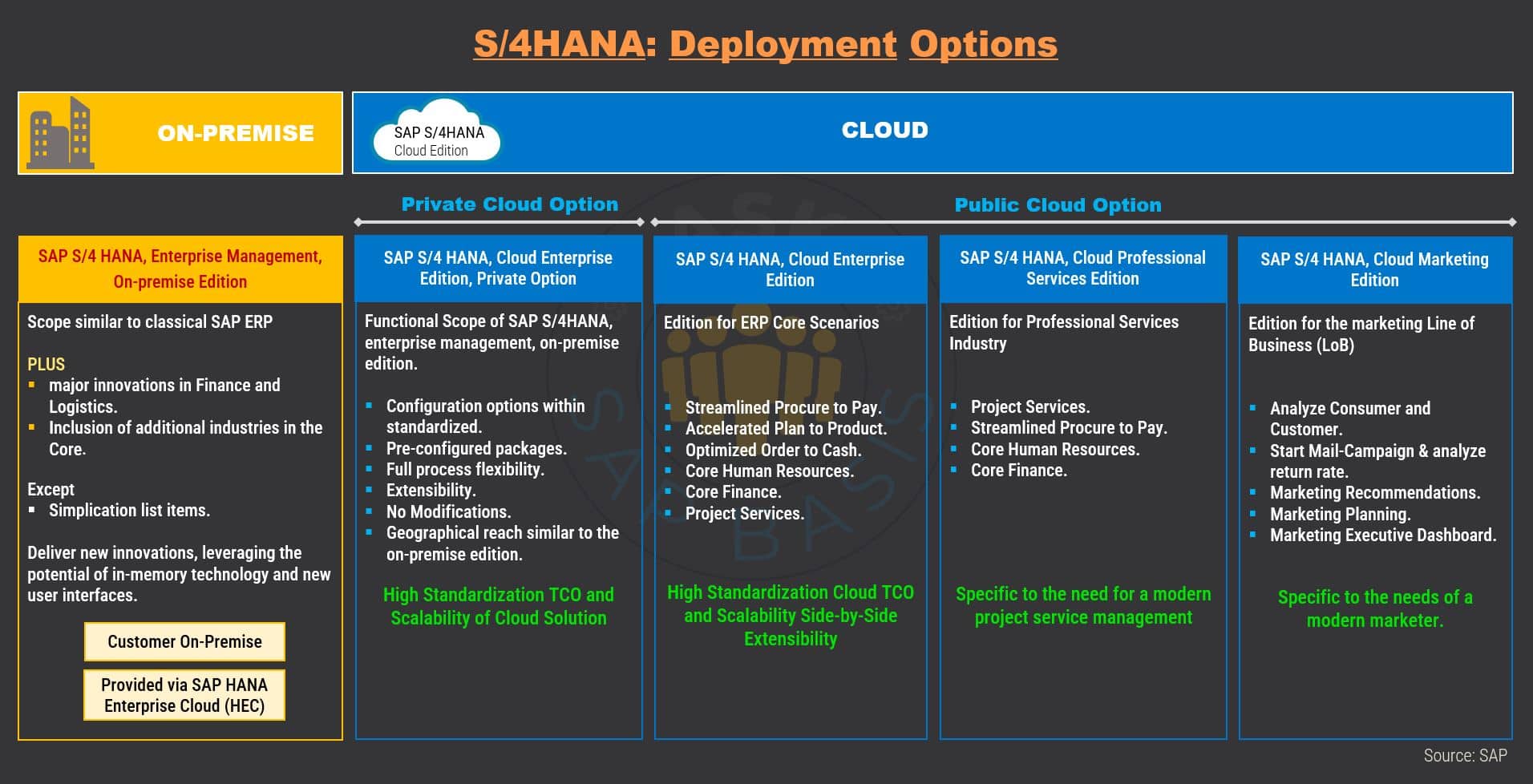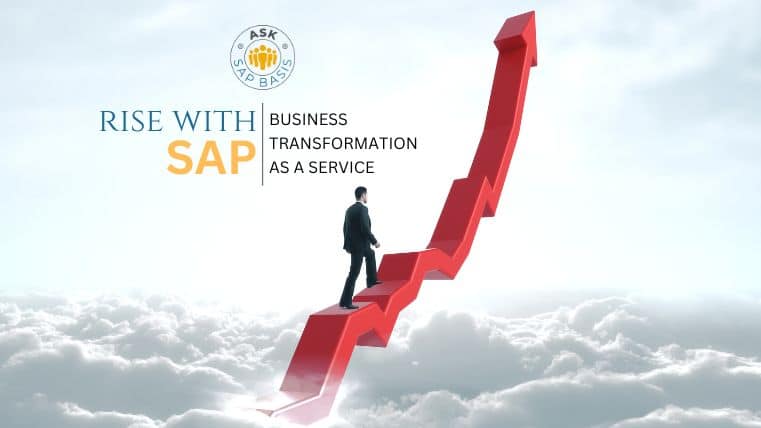SAP S/4HANA: The Future of ERP Explained
Introduction
SAP S/4HANA is successor to R/3 and ERP.
“S” stands for Simple and “4” stands for 4th generation of SAP ERP: R/2, R/3, ERP and S/4HANA.
S/4HANA is an enterprise application suite for SAP HANA. It is an updated version of Business Suite 7 taking advantage of the HANA platform. Its architecture is based on distinct pillars: Multi-Core Computing, In-Memory, and Column and Row Store. Delivered through a simplified and enhanced end-user interface based on SAP Fiori, available in cloud and on-premise. With its in-memory database, it allows you to perform transactions and analyze data in real-time.
It reorganizes SAP ECC modules into Lines of business comprising functions for specific business processes. It includes advanced technologies, like embedded analytics, robotic process automation, machine learning, AI, and IoT. It offers flexibility, lower costs, and faster analytics.
Evolution
SAP S/4HANA was launched on 3rd Feb 2015 at New York Stock exchange with the introduction of on-premises and Cloud editions.

Why did SAP introduced S/4HANA?
SAP S/4HANA was introduced to address the evolving needs of modern businesses. Leveraging cutting-edge technological advancements, S/4HANA empowers businesses to adopt the latest business models, catering to a global customer base.
S/4HANA adopts a modular approach, offering two core solution sets to diverse needs of individual businesses:
- Enterprise Management: This solution streamlines day-to-day operational business processes, ensuring efficient core business functionality.
- Line of Business (LoB): This set of solution extends and enhances specific functionalities depending on your organizations unique requirements.
The platform offers several advantages, allowing users to customize their usage according to their needs while benefitting from:
- underlying powerful in-memory data management and application platform, called SAP HANA.
- advanced and flexible User experience across devices through a design approach , called FIORI.
Additionally, S/4HANA promotes a cost-effective approach:
- Pay-as-you-go model: Customers only pay for the functionalities they use.
- Scalable solution: Businesses can start with the core suite and expand it as their needs evolve, eliminating the upfront cost of purchasing the entire package.
Line of Business (LoB)
LoB refers to specific functional areas or departments within an organization that focus on specific business activities or processes. LoBs are typically defined based on the organizational structure and the different functions performed by various teams or departments.
SAP S/4HANA integrates various business functions, such as finance, sales, procurement, manufacturing, and more. Within S/4HANA, LoBs represent these different functional areas, and the system provides specific modules and capabilities tailored to each LoB’s requirements.
For example, some common LoB’s in S/4HANA include:
- Finance
- Human Resource
- Sourcing and Procurement
- Manufacturing
- Marketing
- Supply Chain
- Sales
- Embedded Warehouse Management
- Transport Management
It also has integration with SAP Success Factor, SAP Ariba, SAP Hybris, SAP Fieldglass and SAP Concur.
Why S/4HANA matters?
In today’s fast-paced digital landscape, companies are faced with the pressing need to be faster, more reliable, and highly efficient. Legacy systems have often proven inadequate, unable to meet the evolving demands of the business world. Additionally, mergers and acquisitions have necessitated the consolidation of solutions, while newly-formed companies emerging from demergers require fresh ERP solutions. This is where S/4HANA comes into play as a leading-edge technological solution.
SAP’s Transition Mandate
SAP has set a deadline for companies to transition to S/4HANA by 2027. This means that businesses must start planning not only which version of SAP they want to adopt but also their future business strategy and vision. Failing to meet SAP’s deadlines will significantly limit your ability to execute digital transformation, putting your company, regardless of its industry, at a competitive disadvantage. So it is not the question “if” to migrate to S/4HANA, but “when” and “how”.
S/4HANA’s Business Advantages
S/4HANA brings a range of automation and innovation capabilities to the table. These capabilities have a profound impact on business practices throughout the entire landscape. By providing end-users with real-time data-driven support, S/4HANA dramatically improves data processing times, reducing them from minutes to mere seconds. This enhancement translates to a better user experience, improved performance, and a significant reduction in the total cost of ownership (TCO).
The automation and innovation capabilities in S/4HANA will help business practices across the entire landscape. S/4HANA provides end users with real-time data-driven support improving the processing of date from min to seconds. It gives a better user experience, improved performance and reduces the total cost of ownership (TCO).
In conclusion, the decision to migrate to S/4HANA extends beyond merely keeping up with the digital age; it’s about positioning your company for success in a rapidly evolving business environment.
Value Proposition
SAP S/4HANA offers numerous benefits to the organization, enabling them to transform their business processes and achieve improved efficiency, agility, and innovation. Below are some value propositions:
- Instant real-time insights for better decisions.
- in-memory technology.
- embedded objects.
- real-time integration
- predictive analytics
- enhanced reporting capabilities
- personalized insights
- agile decision-making
- data driven decision-making
- Re-invented processes for higher performance.
- maximized throughput and speed.
- native integration to SAP solutions.
- process simplification and optimization.
- automation and digitization.
- continuous improvement process.
- advanced analytics for reporting.
- SAP FIORI user experience for higher productivity.
- user-centric design.
- responsive design.
- intuitive on all devices, mobile first.
- context-driven insights.
- proactive decision-making support.
- streamlined workflows.
- enhanced search and filtering.
- personalized user settings.
- collaboration and communication.
- Simplified architecture for lower TCO.
- consolidated data model.
- single source of truth.
- lean data footprint.
- unified platform.
- elimination of batch processing (enables real-time processing & reduces latency).
- simplified interfaces and integrations.
- lower maintenance efforts.
- faster implementation and upgrades.
- improved scalability and performances.
S/4HANA Editions
When considering SAP S/4HANA for your business, it’s essential to understand the various editions available, each tailored to meet specific needs and preferences. Let’s explore the four primary editions:

- SAP S/4HANA On–Premise: The On-Premise edition of SAP S/4HANA represents the traditional approach, allowing you to host the software either in your own data centers or within a hosting provider’s data centers. With this option, you have the freedom to customize the software extensively to align it with your unique requirements. This level of flexibility makes it an ideal choice for businesses with highly specialized processes.
- SAP S/4HANA Cloud: It provides two offerings:
- S/4HANA Private Edition: In contrast, the Private Edition is a Software as a Service (SaaS) offering from SAP. In this version, SAP manages both the software and hosting, offering a higher level of convenience and peace of mind. While customization is still possible, it is somewhat limited compared to the On-Premise edition. This edition strikes a balance between customization and ease of management, making it suitable for a wide range of businesses.
- SAP S/4HANA Public Cloud: Lastly, we have the SAP S/4HANA Cloud edition, a pure SaaS offering with the least flexibility but the easiest management. This edition is well-suited for small businesses or those that can operate efficiently with “out of the box” processes. SAP hosts and manages this edition in the public cloud, simplifying IT management and reducing the need for in-house resources.
The significance of S/4HANA Cloud Public Edition is that it provides a comprehensive set of features and capabilities that empower businesses to standardize business processes, propel digital innovation and transformation, enhance security measures, and remain competitive in the digital age
As part of the GROW with SAP bundle, SAP S/4HANA Cloud, Public Edition offers a seamless transition path. You can migrate to a next-generation ERP system with confidence, knowing your data is protected by industry-leading security practices embedded throughout the platform.
In summary, the choice of SAP S/4HANA edition depends on your organization’s specific needs, ranging from high customization and control to streamlined, hassle-free operations. Evaluate your business requirements carefully to select the edition that best aligns with your goals and processes.
Benefits of S4HANA
S/4HANA Deployment Models
When it comes to implementing SAP S/4HANA, choosing the right deployment model is a critical decision that sets the tone for your entire journey. S/4HANA offers a range of deployment options, including on-premises, cloud, and hybrid models, each catering to unique business needs. Each deployment option provides a different scope of services from SAP.
Understanding Your Landscape
The first step in this journey is to thoroughly understand your current landscape and your vision for the future. Your choice will hinge on whether you’re embarking on a greenfield implementation or a brownfield upgrade, as well as the specific functionalities your organization requires.
Let’s explore these models to help you make an informed choice.
a) S/4HANA On-Premise
Opting for an on-premise deployment provides complete control over your solution. This approach offers flexibility and ease of management, making it an ideal choice if you’ve heavily invested in your infrastructure and desire better control over your software and maintenance.
S/4HANA on-premise is particularly suitable for organizations looking to migrate from their existing ECC (Enterprise Central Component) system.
b) S/4HANA Cloud
S/4HANA Cloud is the Software as a Service (SAAS) version of S/4HANA. One of its major advantages is the alleviation of infrastructure management, allowing you to harness the cloud’s capabilities to streamline processes and reduce Total Cost of Ownership (TCO). While customization options are available, they are comparatively more limited.
Exploring Deployment Options
S/4HANA has two deployment options:
1) S/4HANA Private Cloud
- In the S/4HANA Private Cloud, you gain access to dedicated infrastructure and services, offering a cloud experience akin to having your own on-premise solution.
- This option grants greater flexibility, with SAP providing support for infrastructure and operations. It’s an ideal choice when extensive customization is required, providing the flexibility needed to fine-tune your solution.
- By entrusting SAP with infrastructure management, companies can trim ownership costs while benefiting from cloud-driven innovations and automation capabilities.
2) S/4HANA Public Cloud
- S/4HANA Public Cloud is the cloud-native version of S/4HANA, with infrastructure provided by third-party providers and hosted in SAP data centers. It’s a cost-effective and ready-to-run ERP solution, delivering industry best practices and innovations.
- Moving to the public cloud entails a transformation, as existing processes adapt to the cloud environment.
- Small to medium-sized businesses seeking standardized processes and cost reductions often choose the S/4HANA Public Cloud. Large enterprises can also leverage this option selectively, migrating specific processes based on geographic location, speed, and agility requirements.
In conclusion, selecting the right S/4HANA deployment model is pivotal in achieving your organization’s objectives. Take the time to assess your current state and future aspirations, considering the pros and cons of each option to pave the way for a successful S/4HANA journey.
S/4HANA Cloud Vs On-Premise Comparison
| Criteria | On-Premise | Cloud |
| License | 1) Opex 2) License Fees & Annual Mainteanance 3) License owned by customer | 1) OpenX 2) Annual fees for License & SAAS and maintenance and upgrades 3) License Owned by SAP |
| Investment | Investment on Infrastructure, software, Hardware, storage, and operating system | No investment on infrastructure, software, or hardware |
| Infrastructure & Maintenance | Customers Own the hardware and they IT Team responsible to maintain | Infrastructure is provided by SAP or its selected service providers and managed and maintained by them |
| Security | Customer has the complete control on the Maintaining the security of their Solution | SAP takes care of the security |
| Flexibility | Less Flexible | More Flexible |
| Upgrades | Upgrades are managed by Customers as per their requirement | Managed by SAP |
| Customization | More Customization possible | In case of public cloud configurations are predefined with less adaptability vs for private cloud you can customize as you do in on-premise |
| Benefit | Maximum control and flexibility | High performance and easy to migrate will less TCO |
S/4HANA Transition Approach
Transitioning to SAP HANA, particularly S/4HANA, is a significant milestone for any organization. Before taking the leap, it’s essential to comprehensively assess the deployment and migration options in alignment with your unique business requirements, processes, budget, and timeline.
S/4HANA migration provides companies with improved real-time analytics and access to the latest technologies with AI, process automation, and up-to-date business models.
Let’s delve into why this pre-migration evaluation is vital and how S/4HANA migration can transform your business.
Informed Decision–Making
Moving to SAP HANA is a strategic decision that warrants a thorough understanding of its implications. It’s not a one-size-fits-all scenario; rather, it’s about making choices that align with your organization’s goals and operational landscape.
Evaluate the pros and cons of deployment and migration options. Consider factors such as:
- Business Needs: How will SAP HANA support your business objectives, including real-time analytics and access to advanced technologies like AI?
- Business Processes: How will the transition impact your existing processes? What improvements can be expected in terms of efficiency and productivity?
- Cost: What is the financial commitment involved in your chosen approach, both short-term and long-term?
- Timeline: How quickly do you need to make this transition? Does your chosen approach align with your timeline?
By carefully considering your options and understanding the transformative power of S/4HANA, your organization can embark on a migration journey that not only meets your immediate needs but also positions you for a future of enhanced competitiveness and innovation.
Greenfield Approach (New Implementation)
In context to SAP implementation, a greenfield approach is a new vanilla implementation that represents a fresh start—a blank canvas free from customization or technical baggage. This approach involves building a new system from the ground up, offering a transformative but disruptive journey for your business users. Let’s delve into the key aspects and advantages of the greenfield approach.
- Greenfield approach involves complete re-engineering of the organization’s SAP processes and workflows.
- The greenfield implementation is an opportunity for a complete overhaul of your organization’s SAP processes and workflows. The result? Streamlined, efficient processes that align seamlessly with the latest innovations in S/4HANA.
- This approach empowers organizations to not only adapt to S/4 innovations but to fully embrace them. Redesigning existing, perhaps undesirable, business processes becomes possible, leading to a reduction in the total cost of ownership and a swift path to realizing value.
- As greenfield involves the building of a new system, it prioritize standardization and simplicity right from the start. While it enables a rapid setup of the S/4 system, data migration can be time-consuming process.
- Greenfield implementation involves a larger risk as you will have to develop the critical customization again in the new system, which will increase the time for your overall migration. In order to minimize the risk, you can do selective migration in some areas.
Ultimately, the greenfield approach is a bold strategy that promises substantial rewards. By embracing this approach, organizations can revamp their processes, leverage the full potential of S/4HANA, and embark on a journey toward greater standardization and efficiency.
Brownfield Approach (System Conversion)
The Brownfield approach is the ideal choice for customers who wish to build upon their existing SAP infrastructure rather than starting from scratch, allowing them to preserve some of their customizations. It’s a strategy rooted in evolution rather than revolution.
- Brownfield is all about upgrading an existing SAP implementation rather than transforming it.
- Brownfield primarily focuses on database migration and application conversion. This means that it involves less time and is generally less disruptive to your business compared to other migration approaches.
- A key hallmark of the brownfield approach is its emphasis on continuity. It involves migrating and adapting all your business processes to the new S/4HANA platform without causing any disruption to your existing operations. This smooth transition minimizes the risk of workflow interruptions and ensures business continuity throughout the migration process.
- With Brownfield, you have the freedom to assess your existing business processes and customizations. You can then choose which elements to transfer to the new system. This level of flexibility empowers you to retain the customizations that best serve your business objectives, streamlining the migration process.
- With brownfield you can evaluate your existing business process and the customizations and move the ones you want in new system.
- Another compelling aspect of the Brownfield approach is its cost-effectiveness. Since you’re not building entirely new processes that you wish to retain, it leads to reduced expenses. Additionally, this approach contributes to a shorter overall migration timeline, minimizing the impact on your operations.
In summary, the Brownfield approach offers a balanced migration strategy for organizations looking to upgrade to SAP S/4HANA. It allows you to build upon your existing strengths, seamlessly integrating them into the new platform while optimizing cost-efficiency and minimizing disruptions to your business processes.
Bluefield Approach (Selective Data Transition)
The Bluefield approach, often referred to as Selective Data Transition, offers a dynamic strategy for transferring data from one or more ERP solutions to a new S/4HANA solution.
- It ingeniously merges the strengths of both the greenfield and brownfield approaches, making it an ideal choice for enterprises with substantial complexity and vast data repositories.
- Bluefield requires 3rd party tools to distil the pieces of greenfield and brownfield that are part of your transformation plan.
- Bluefield empowers large enterprises to reevaluate their data and customizations while realigning their systems with new S/4HANA business principles.
- This selective data transition approach allows organizations to meticulously choose which processes to redesign and which to retain, facilitating a more customized transformation.
- One of the standout features of bluefield approach is its capacity to enable gradual and selective transformation. Rather than implementing changes across the board, businesses can strategically target specific areas, optimizing efficiency and minimizing disruption.
- The transfer of data involves the use of specialized tools to extract the configuration without data, migrate it to S/4HANA, and then migrate the data. The data selectively transferred can include:
- ABAP repository of objects and development
- Configuration (customizing) data
- Master data
- Transaction data (open items and time slices of historical closed items)
Choosing the Right Approach
In the end, the choice of migration approach hinges on your business objectives and organizational vision.
Before finalizing your strategy, it’s essential to thoroughly understand your business needs, create a solid business case, and develop a comprehensive strategy following the “SAP Activate methodology” roadmap.
- If you are a smaller enterprise that wants to quickly transform your business and utilize the benefits of innovation, overhaul business processes, and adopt a cloud solution, you can go for a greenfield implementation.
- If you are on ECC and want to keep your existing customizations, you can go for brownfield approach.
- If you have multiple instances of SAP ECC and want to consolidate them, you can go for a bluefield migration approach.
To summarize, the right migration approach should align seamlessly with your organization’s objectives, ensuring a successful transition to SAP S/4HANA that optimizes your processes and delivers tangible benefits.
Migration Challenges
Migrating to SAP S/4HANA is not your typical IT project; it represents a fundamental shift in your system landscape. This transformative journey comes with its share of challenges, including:
1) Complexity of the Existing IT Landscape
One of the foremost challenges lies in the complexity of your current IT environment. The more intricate your existing setup, the more intricate the migration process becomes. Managing and aligning legacy systems, processes, and customizations can be a formidable task.
2) Customization Complexity and Compatibility
Extensive customizations in your current system can significantly prolong the migration timeline. Additionally, not all customizations may seamlessly transition to S/4HANA. Ensuring compatibility and, when necessary, reengineering customizations adds complexity to the project.
3) Handling Vast Amounts of Data
For organizations with substantial data stores, data migration is a time-consuming and resource-intensive endeavor. Ensuring the completeness and accuracy of data during migration is paramount for a successful transition.
4) Ensuring Technical Compatibility with Connected Systems
Integration with satellite systems is a critical aspect of migration. Ensuring that these systems remain technically compatible and function smoothly with the new S/4HANA environment is a challenge that requires meticulous planning and execution.
5) Managing Costs
The cost of migration can escalate, particularly when dealing with a multitude of customizations. Careful budgeting and cost management are essential to prevent unforeseen expenses from impacting your project.
6) Comprehensive Testing
Extensive testing is a necessity to ensure that all critical business processes function as expected in the S/4HANA environment. Rigorous testing helps identify and resolve issues before they affect day-to-day operations.
7) Disruption During Migration
Migrating to S/4HANA is a process that can span several months. During this period, there may be disruptions to business operations. Effective planning and minimizing downtime are essential to mitigate these disruptions.
In conclusion, while SAP S/4HANA migration comes with its set of challenges, careful planning, meticulous execution, and a thorough understanding of your organization’s unique requirements can help you overcome these hurdles and ensure a smooth transition to a more efficient and agile ERP system.
S/4HANA Releases
SAP provides frequent releases for its on-premise, cloud, hybrid, and mobile solutions.
- SAP S/4HANA on-premise releases are once a year. (the version codes are YYYY).
- SAP S/4HANA cloud releases are twice a year. (the version codes are YYMM).
SAP S/4HANA On-Premises Releases
- SAP S/4HANA Finance 1503: March 2015
- SAP S/4HANA 1511: November 2015
- SAP S/4HANA Finance 1605: May 2016
- SAP S/4HANA 1610: October 2016
- SAP S/4HANA 1709: September 2017
- SAP S/4HANA 1809: September 2018
- SAP S/4HANA 1909: September 2019 [20]
- SAP S/4HANA 2020: October 2020 [21] (new nomenclature: switch to YYYY from YYMM)
- SAP S/4HANA 2021: October 2021
- SAP S/4HANA 2022: October 2022
SAP S/4HANA Cloud Releases
- SAP S/4HANA Cloud 1603: March 2016
- SAP S/4HANA Cloud 1605: May 2016
- SAP S/4HANA Cloud 1608: August 2016
- SAP S/4HANA Cloud 1611: November 2016
- SAP S/4HANA Cloud 1702: February 2017
- SAP S/4HANA Cloud 1705: May 2017
- SAP S/4HANA Cloud 1708: August 2017
- SAP S/4HANA Cloud 1711: November 2017
- SAP S/4HANA Cloud 1802: February 2018
- SAP S/4HANA Cloud 1805: May 2018
- SAP S/4HANA Cloud 1808: August 2018
- SAP S/4HANA Cloud 1811: November 2018
- SAP S/4HANA Cloud 1902: February 2019
- SAP S/4HANA Cloud 1908: August 2019
- SAP S/4HANA Cloud 1911: November 2019
- SAP S/4HANA Cloud 2002: January 2020
- SAP S/4HANA Cloud 2005: April 2020
- SAP S/4HANA Cloud 2008: July 2020
- SAP S/4HANA Cloud 2011: November 2020
- SAP S/4HANA Cloud 2102: February 2021
- SAP S/4HANA Cloud 2105: May 2021
- SAP S/4HANA Cloud 2108: August 2021
- SAP S/4HANA Cloud 2111: November 2021
- SAP S/4HANA Cloud 2022: available February 2022
Major releases regularly contain major new functionality, architectural platform changes, or both. Feature packages are delivered on a quarterly basis and contain new features plus corrections and legal changes.
From Release 2023 of SAP S/4HANA, SAP will have a two-year release cycle and seven years of mainstream maintenance per release, with more easily adoptable feature packs.
On releases 1709, 1809, and 1909 of SAP S/4HANA SAP will offer an extended maintenance option, which will help customers directly upgrade to the 2023 version.
Until 2040, there will be at least one release of SAP S/4HANA under maintenance.
Summary
SAP S/4HANA helps customers to undergo digital transformation enabling customers to make business decisions informed by real time insights , machine learning , IoT and other innovative capabilities. It acts has digital core of the organization which is designed to run an intelligent Enterprise . It allows companies to be more flexible , responsive and resilient to changing business requirements , customer demands and environment conditions. It provides organization to combine their analytical and transactional capabilities of different systems in a single system for easier business decisions. It is integration ready








